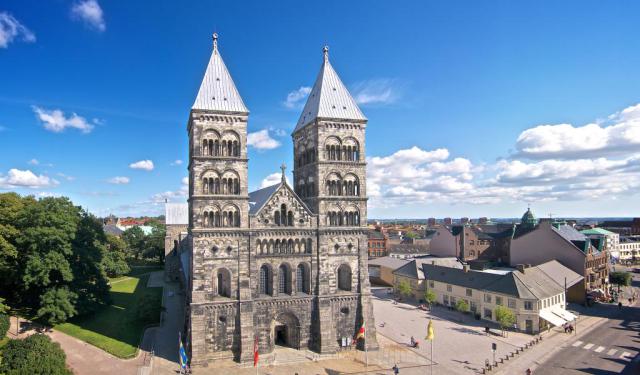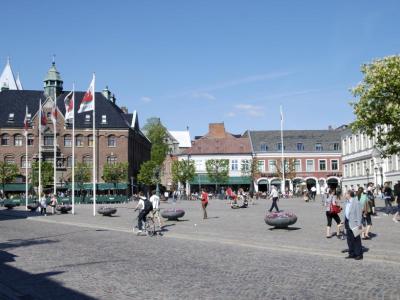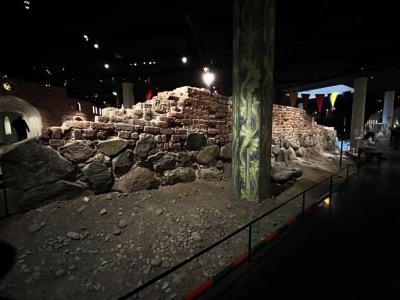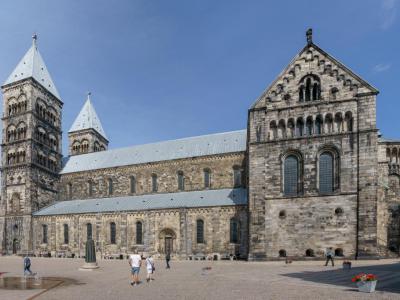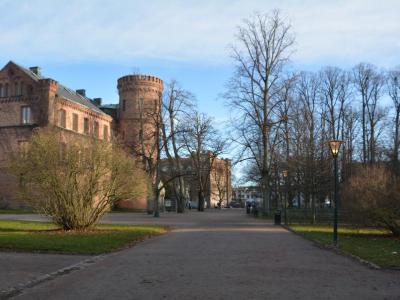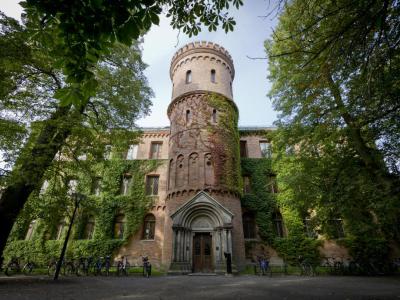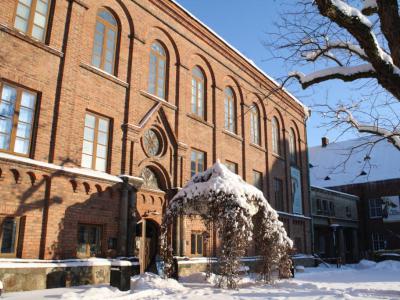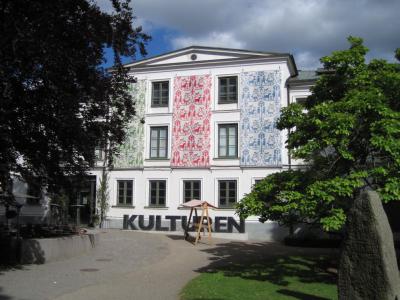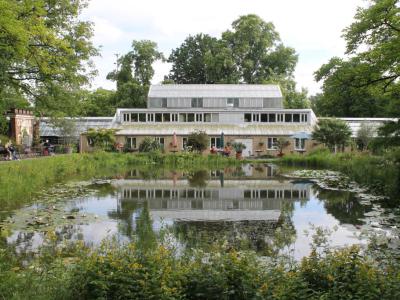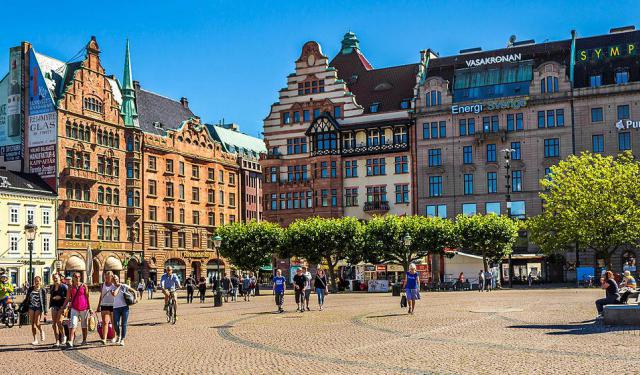Lund Walking Tour (Self Guided), Malmo
Lund is a verdant city famed primarily for its academic prowess and as the backdrop for the final scenes of Ingmar Bergman’s renowned movie, "Wild Strawberries". Situated just about 15 kilometers (9.3 miles) northeast of Malmo, it makes a perfect day-trip destination.
At the heart of the city lies Stortorget, the bustling central square where locals gather and events take place. Nearby, the haunting beauty of Drotten Church Ruins stands as a testament to the city's medieval past.
During the Middle Ages, Lund held significant influence as the seat of an archbishopric, exerting authority over the Nordic countries. Reflecting this religious prominence is the majestic Lund Cathedral, hailed as the foremost Romanesque structure in Scandinavia. Exploring it tops anyone's list when visiting Lund.
The adjacent Lund Garden Park, or Lundagard, offers a serene retreat amidst the urban bustle, while the King's House (Kungshuset) adds a royal touch to the cityscape.
As a hub of higher education, Lund offers an array of attractions associated with its esteemed university, notably the Lund University Main Building, an architectural marvel in its own right. History enthusiasts can delve into the city's past at the Lund University Historical Museum, which chronicles centuries of scholarly endeavors and cultural evolution, whereas nature lovers will find solace in the Botanical Gardens (Botaniska Tradgarden).
For a deeper exploration of Swedish heritage, Kulturen in Lund beckons with its Open-Air Museum of Cultural History, the country's second oldest outdoor museum. This charming enclave of historical buildings preserves traditional trades and daily routines predating industrialization and as such offers a glimpse into the lives of generations past.
So, whenever you're in Malmo, plan a visit to Lund. There's a strong chance, you'll come back with some unforgettable memories. This lovely Swedish city awaits your exploration!
At the heart of the city lies Stortorget, the bustling central square where locals gather and events take place. Nearby, the haunting beauty of Drotten Church Ruins stands as a testament to the city's medieval past.
During the Middle Ages, Lund held significant influence as the seat of an archbishopric, exerting authority over the Nordic countries. Reflecting this religious prominence is the majestic Lund Cathedral, hailed as the foremost Romanesque structure in Scandinavia. Exploring it tops anyone's list when visiting Lund.
The adjacent Lund Garden Park, or Lundagard, offers a serene retreat amidst the urban bustle, while the King's House (Kungshuset) adds a royal touch to the cityscape.
As a hub of higher education, Lund offers an array of attractions associated with its esteemed university, notably the Lund University Main Building, an architectural marvel in its own right. History enthusiasts can delve into the city's past at the Lund University Historical Museum, which chronicles centuries of scholarly endeavors and cultural evolution, whereas nature lovers will find solace in the Botanical Gardens (Botaniska Tradgarden).
For a deeper exploration of Swedish heritage, Kulturen in Lund beckons with its Open-Air Museum of Cultural History, the country's second oldest outdoor museum. This charming enclave of historical buildings preserves traditional trades and daily routines predating industrialization and as such offers a glimpse into the lives of generations past.
So, whenever you're in Malmo, plan a visit to Lund. There's a strong chance, you'll come back with some unforgettable memories. This lovely Swedish city awaits your exploration!
How it works: Download the app "GPSmyCity: Walks in 1K+ Cities" from Apple App Store or Google Play Store to your mobile phone or tablet. The app turns your mobile device into a personal tour guide and its built-in GPS navigation functions guide you from one tour stop to next. The app works offline, so no data plan is needed when traveling abroad.
Lund Walking Tour Map
Guide Name: Lund Walking Tour
Guide Location: Sweden » Malmo (See other walking tours in Malmo)
Guide Type: Self-guided Walking Tour (Sightseeing)
# of Attractions: 9
Tour Duration: 1 Hour(s)
Travel Distance: 1.8 Km or 1.1 Miles
Author: DanaOffice
Sight(s) Featured in This Guide:
Guide Location: Sweden » Malmo (See other walking tours in Malmo)
Guide Type: Self-guided Walking Tour (Sightseeing)
# of Attractions: 9
Tour Duration: 1 Hour(s)
Travel Distance: 1.8 Km or 1.1 Miles
Author: DanaOffice
Sight(s) Featured in This Guide:
- Stortorget (City Central Square)
- Drotten Church Ruins
- Lund Cathedral
- Lundagard (Lund Garden Park)
- Kungshuset (King's House)
- Lund University Main Building
- Lund University Historical Museum
- Kulturen (Museum of Cultural History and Open-Air Museum)
- Botaniska Tradgarden (Botanical Gardens)
1) Stortorget (City Central Square)
The City Central Square has historical roots dating back to medieval times when the town was established. In its early days, it was a trilateral wooden-planked space serving both as a trading hub and a symbolic venue for the church and king to address the people.
Archaeological findings suggest that the square was established in the mid-11th century as a triangular extension of Stora Södergatan Street. By the 12th century, the entire surface of the square was covered with wooden boards, eventually being paved in the following century.
In the early and mid-20th century, City Central Square underwent significant reconstruction, resulting in its contemporary appearance. Notably, the modern town hall building, designed by the architect Anshelm Class, stands as one of his most significant works and contributes to the square's present charm. Today, Stortorget is a pedestrian-friendly space, closed to car traffic, allowing people to stroll and cycle through its historic surroundings.
Additionally, Stortorget is surrounded by numerous shops, adding to the vibrant atmosphere of this central square in Lund.
Archaeological findings suggest that the square was established in the mid-11th century as a triangular extension of Stora Södergatan Street. By the 12th century, the entire surface of the square was covered with wooden boards, eventually being paved in the following century.
In the early and mid-20th century, City Central Square underwent significant reconstruction, resulting in its contemporary appearance. Notably, the modern town hall building, designed by the architect Anshelm Class, stands as one of his most significant works and contributes to the square's present charm. Today, Stortorget is a pedestrian-friendly space, closed to car traffic, allowing people to stroll and cycle through its historic surroundings.
Additionally, Stortorget is surrounded by numerous shops, adding to the vibrant atmosphere of this central square in Lund.
2) Drotten Church Ruins
Drotten's Church Ruins unveil a hidden gem beneath the unassuming surface of the city's main shopping district. Nestled beneath an ordinary-looking street, this underground museum invites visitors to explore the captivating remnants of several medieval churches that once graced the same plot of land between the 11th and 14th centuries.
To discover this intriguing site, visitors can enter through an inconspicuous green door at street level or through an Italian restaurant, whose terrace bustles with diners during the summer months. A spiral staircase guides visitors down to a spacious, dimly lit hall featuring low walls that mark the remains of the historic churches.
The church ruin of Saint Drotten, believed to date back to 1050, reveals itself as an oddly shaped 50-meter-long structure, possibly serving as the bishop's church. The medieval stone church was discovered during excavation work in the 1970s and 80s, uncovering traces of an even older wooden church, possibly built by the Danish king Sweyn Forkbeard, making it the oldest church in Skåne. The excavation work also unearthed remnants of the monastery, adding another layer to the historical narrative.
The museum, established around the ruins, is a public and free attraction. Visitors can explore this unique space, gaining insights into the evolution of the churches over centuries and the rich history embedded in Lund's underground heritage.
To discover this intriguing site, visitors can enter through an inconspicuous green door at street level or through an Italian restaurant, whose terrace bustles with diners during the summer months. A spiral staircase guides visitors down to a spacious, dimly lit hall featuring low walls that mark the remains of the historic churches.
The church ruin of Saint Drotten, believed to date back to 1050, reveals itself as an oddly shaped 50-meter-long structure, possibly serving as the bishop's church. The medieval stone church was discovered during excavation work in the 1970s and 80s, uncovering traces of an even older wooden church, possibly built by the Danish king Sweyn Forkbeard, making it the oldest church in Skåne. The excavation work also unearthed remnants of the monastery, adding another layer to the historical narrative.
The museum, established around the ruins, is a public and free attraction. Visitors can explore this unique space, gaining insights into the evolution of the churches over centuries and the rich history embedded in Lund's underground heritage.
3) Lund Cathedral
Lund Cathedral stands as a remarkable testament to medieval architecture and holds the distinction of being the oldest cathedral in Scandinavia. Construction of the cathedral commenced in 1104 as a Romanesque basilica, and in 1145 the nearly completed structure was consecrated to Saint Laurentius of Rome.
Among its many attractions, Lund Cathedral boasts the renowned astronomical clock, positioned just next to the main entrance. Crafted around 1425, this technical marvel is one of only three such clocks in Europe. Beyond displaying the time on a 24-hour dial, the clock also showcases moon phases, zodiac signs, and a calendar spanning 200 years. Daily at 12 and 3 pm, a small built-in organ plays the medieval jubilee In dulci jubilo, accompanied by a procession of three kings representing medieval continents and Mary with the child Jesus passing by.
The cathedral's crypt stands out as one of the most well-preserved examples of medieval architecture in Northern Europe, featuring a ceiling construction with 41 cross vaults supported by a forest of pillars. Notably, one column is adorned with the sculpture of a giant, known as Finn, who, according to legend, fled to the crypt after losing a bet with Saint Laurentius and turned into stone.
The pulpit on the north side of the central nave is a masterpiece, created in 1592 by German sculptor Johannes Ganssog. Constructed from sandstone, limestone, black and white marble, as well as alabaster, it is considered one of the most magnificent works of Nordic Renaissance.
The cathedral houses several organs, with the main organ on the west gallery being the largest church organ in Sweden, boasting 102 registers and 7074 pipes.
Among its many attractions, Lund Cathedral boasts the renowned astronomical clock, positioned just next to the main entrance. Crafted around 1425, this technical marvel is one of only three such clocks in Europe. Beyond displaying the time on a 24-hour dial, the clock also showcases moon phases, zodiac signs, and a calendar spanning 200 years. Daily at 12 and 3 pm, a small built-in organ plays the medieval jubilee In dulci jubilo, accompanied by a procession of three kings representing medieval continents and Mary with the child Jesus passing by.
The cathedral's crypt stands out as one of the most well-preserved examples of medieval architecture in Northern Europe, featuring a ceiling construction with 41 cross vaults supported by a forest of pillars. Notably, one column is adorned with the sculpture of a giant, known as Finn, who, according to legend, fled to the crypt after losing a bet with Saint Laurentius and turned into stone.
The pulpit on the north side of the central nave is a masterpiece, created in 1592 by German sculptor Johannes Ganssog. Constructed from sandstone, limestone, black and white marble, as well as alabaster, it is considered one of the most magnificent works of Nordic Renaissance.
The cathedral houses several organs, with the main organ on the west gallery being the largest church organ in Sweden, boasting 102 registers and 7074 pipes.
4) Lundagard (Lund Garden Park)
Positioned between Lund Cathedral, the historical museum, and the university square, Lund Garden has evolved into a cherished destination for both locals and visitors. Originally conceived as a green oasis, Lundagård was designed to cater to the citizens and a burgeoning student population in the town center, which lacked substantial tree cover at the time of its creation. The park occupies ground with historical resonance, dating back to the late 9th century when it was crown land.
Among the park's venerable landmarks are the Lund Cathedral, situated on the southern edge, and King's House in the northern part. King's House, completed as a royal residence in 1584, served various roles over the centuries, including a brief period as a bishop's residence and, from around 1690 to 1882, as the first main building of the university, founded in 1666.
Lundagård seamlessly transitions into the university square on its north side, leading to the current main building of the university. The square, adorned with a grand historical fountain, serves as a fitting prelude to the impressive university building inaugurated in 1882.
Beyond its historical and architectural significance, Lundagård Park also plays a central role in cultural festivities. Every four years, the park becomes the vibrant stage for Lundakarnevalen, a carnival event boasting over 150 years of tradition. Organized by student associations, this lively celebration adds a spirited dimension to Lundagård's multifaceted allure, making it a dynamic focal point in Lund's cultural landscape.
Among the park's venerable landmarks are the Lund Cathedral, situated on the southern edge, and King's House in the northern part. King's House, completed as a royal residence in 1584, served various roles over the centuries, including a brief period as a bishop's residence and, from around 1690 to 1882, as the first main building of the university, founded in 1666.
Lundagård seamlessly transitions into the university square on its north side, leading to the current main building of the university. The square, adorned with a grand historical fountain, serves as a fitting prelude to the impressive university building inaugurated in 1882.
Beyond its historical and architectural significance, Lundagård Park also plays a central role in cultural festivities. Every four years, the park becomes the vibrant stage for Lundakarnevalen, a carnival event boasting over 150 years of tradition. Organized by student associations, this lively celebration adds a spirited dimension to Lundagård's multifaceted allure, making it a dynamic focal point in Lund's cultural landscape.
5) Kungshuset (King's House)
The King's House is a historic building, commissioned by Danish king Frederick II and constructed between 1578 and 1584. Originally designated as the residence for the bishop of Lund, the building took on a new role following the secession of the Scanian lands to Sweden in 1658. Lund University was founded in 1666 to promote the Swedification of the Danish provinces, and in 1688, King Charles XI donated Kungshuset to the university. It became the main building and library, accommodating the entire university until around 1800.
Within Kungshuset, there was a theater for anatomical dissection demonstrations and an observatory used by the university's first astronomer, Anders Spole. While a local legend suggests that King Charles XII rode up the tower's wide wooden stairs during his residence in Lund in the 1710s, this claim is debunked as the tower was added later in the 18th century.
In the mid-19th century, Kungshuset housed the University Library but faced challenges, such as a leaking roof. Professor Carl Georg Brunius, renowned for his contributions to Lund's architecture, took it upon himself to improve the building's condition. Until 2014, Kungshuset served as the location for the Department of Philosophy.
Within Kungshuset, there was a theater for anatomical dissection demonstrations and an observatory used by the university's first astronomer, Anders Spole. While a local legend suggests that King Charles XII rode up the tower's wide wooden stairs during his residence in Lund in the 1710s, this claim is debunked as the tower was added later in the 18th century.
In the mid-19th century, Kungshuset housed the University Library but faced challenges, such as a leaking roof. Professor Carl Georg Brunius, renowned for his contributions to Lund's architecture, took it upon himself to improve the building's condition. Until 2014, Kungshuset served as the location for the Department of Philosophy.
6) Lund University Main Building
The Lund University Main Building stands as a majestic testament to Lund's rich history as a hub of learning and education. The roots of scholarly pursuits in Lund date back to 1085, with the establishment of a cathedral school dedicated to clergy training. This school, Scandinavia's oldest, laid the foundation for the academic legacy that would later be embodied by Lund University.
Founded in 1425 as a studium generale, Lund University began its educational journey in 1438 under the guidance of the Franciscan order, offering a baccalaureus degree. As the student population burgeoned, the need for a new main building became evident. In response, the renowned architect Helgo Zettervall took up the task, and the grand inauguration by King Oscar II took place in 1882.
Zettervall's design for the Lund University Main Building reflects his deep admiration for classical antiquity. The structure boasts distinctive features, including columns and intricate copings, evoking a sense of timeless elegance. Originally adorned with four sphinxes on the roof, these mythical creatures had to be removed within three decades due to quality issues. However, in the 1990s, four new sphinxes were added to the building, restoring a touch of mythical allure to its architectural profile.
Founded in 1425 as a studium generale, Lund University began its educational journey in 1438 under the guidance of the Franciscan order, offering a baccalaureus degree. As the student population burgeoned, the need for a new main building became evident. In response, the renowned architect Helgo Zettervall took up the task, and the grand inauguration by King Oscar II took place in 1882.
Zettervall's design for the Lund University Main Building reflects his deep admiration for classical antiquity. The structure boasts distinctive features, including columns and intricate copings, evoking a sense of timeless elegance. Originally adorned with four sphinxes on the roof, these mythical creatures had to be removed within three decades due to quality issues. However, in the 1990s, four new sphinxes were added to the building, restoring a touch of mythical allure to its architectural profile.
7) Lund University Historical Museum
The Lund University Historical Museum in Malmö is a treasure trove of archaeological finds, medieval church art, and coins, making it the largest museum of its kind in southern Sweden. Established in 1805, it holds the distinction of being the second-largest archaeological museum in the country. The museum’s extensive collection features artifacts from the richest Iron Age settlement in the Nordic region, Uppåkra, as well as items from the Scanian Stone, Bronze, and Iron Ages.
With four floors of exhibits, the museum presents a diverse range of themes including history, archaeology, art, zoology, and numismatics. One of its standout exhibitions, Barbaricum, showcases unique objects from Uppåkra, the largest Iron Age city in the Nordic countries. The collection also includes the largest medieval coin treasure in Sweden and an impressive display of Classical Antiquity artifacts obtained through university-led excavations abroad.
The top floor's Hall of Antiques greets visitors with mighty statues and an intriguing gallery of people from different eras. Sculptures of medieval saints, along with splendid gold and silver church items, illustrate the rich ecclesiastical history of the region. A special section dedicated to Lund Cathedral features unique building elements, textiles, and vestments spanning various periods.
As part of Lund University’s cultural and museum activities (LUKOM), the museum is committed to research, education, and public engagement. Its mission includes preserving and displaying archaeological finds from the Skåne region-home to around eleven million artifacts. While not all items are on display, the museum continues to be a hub for research and a fascinating destination for those looking to explore southern Sweden’s rich history.
With four floors of exhibits, the museum presents a diverse range of themes including history, archaeology, art, zoology, and numismatics. One of its standout exhibitions, Barbaricum, showcases unique objects from Uppåkra, the largest Iron Age city in the Nordic countries. The collection also includes the largest medieval coin treasure in Sweden and an impressive display of Classical Antiquity artifacts obtained through university-led excavations abroad.
The top floor's Hall of Antiques greets visitors with mighty statues and an intriguing gallery of people from different eras. Sculptures of medieval saints, along with splendid gold and silver church items, illustrate the rich ecclesiastical history of the region. A special section dedicated to Lund Cathedral features unique building elements, textiles, and vestments spanning various periods.
As part of Lund University’s cultural and museum activities (LUKOM), the museum is committed to research, education, and public engagement. Its mission includes preserving and displaying archaeological finds from the Skåne region-home to around eleven million artifacts. While not all items are on display, the museum continues to be a hub for research and a fascinating destination for those looking to explore southern Sweden’s rich history.
8) Kulturen (Museum of Cultural History and Open-Air Museum)
Kulturen is a unique museum that seamlessly combines indoor and outdoor experiences, offering a captivating journey through history and culture. The museum is situated across two interconnected sites in the heart of Lund, and showcases a diverse collection of historic buildings and picturesque gardens.
As you explore the museum, you'll have the opportunity to step inside carefully preserved buildings, providing an immersive experience of life spanning the Middle Ages to the 1930s. From folk art to modern design, medieval history to contemporary culture, and local traditions to global influences, there's something for every interest. These exhibitions provide a comprehensive overview of cultural evolution over the centuries.
To satisfy your appetite, the museum features a café offering delectable pastries, snacks, and ice cream. For those seeking a heartier meal, Kulturkrogen, the museum's restaurant located next to the entrance building, provides a convenient and delightful dining experience.
Before concluding your visit, don't forget to explore the museum shop in the entrance hall. Here, you'll discover an array of books covering various museum topics and a curated selection of handicraft products representing the rich cultural heritage of the region.
As you explore the museum, you'll have the opportunity to step inside carefully preserved buildings, providing an immersive experience of life spanning the Middle Ages to the 1930s. From folk art to modern design, medieval history to contemporary culture, and local traditions to global influences, there's something for every interest. These exhibitions provide a comprehensive overview of cultural evolution over the centuries.
To satisfy your appetite, the museum features a café offering delectable pastries, snacks, and ice cream. For those seeking a heartier meal, Kulturkrogen, the museum's restaurant located next to the entrance building, provides a convenient and delightful dining experience.
Before concluding your visit, don't forget to explore the museum shop in the entrance hall. Here, you'll discover an array of books covering various museum topics and a curated selection of handicraft products representing the rich cultural heritage of the region.
9) Botaniska Tradgarden (Botanical Gardens)
The Botanical Garden, part of Lund University, boasts a distinctive collection of over 7,000 diverse plants, flowers, and trees. Established in 1690 at a different location (currently occupied by Lund University's main building), the garden was later relocated to its present site around a century later. By 1868, the majority of the plants had been successfully transferred.
Spanning 8 hectares, the garden features university buildings, the Botanical Museum, artworks by Swedish artists and The Yellow Villa. The historic villa is known for its distinct yellow color and has become an iconic part of the botanical garden's landscape. The garden continues to serve as a research hub for Lund University.
At the heart of the Lund Botanical Garden stands a conservatory greenhouse housing over 2,000 plant and tree species from nine distinct climate zones, including those from deserts and rainforests. The greenhouse, dating back to 1865, offers a unique opportunity to experience diverse climates, and adjacent to it is the Orangerie, hosting regular plant-related exhibitions. The greenhouse is open daily from 11 am to 3 pm, and admission is free.
Amidst the garden, adjacent to the conservatory, lies Café Botan, an ideal spot for fika (Swedish coffee break) or simply to relax while exploring. Open during the summer months, Café Botan is part of the renowned Patisseriet.
Spanning 8 hectares, the garden features university buildings, the Botanical Museum, artworks by Swedish artists and The Yellow Villa. The historic villa is known for its distinct yellow color and has become an iconic part of the botanical garden's landscape. The garden continues to serve as a research hub for Lund University.
At the heart of the Lund Botanical Garden stands a conservatory greenhouse housing over 2,000 plant and tree species from nine distinct climate zones, including those from deserts and rainforests. The greenhouse, dating back to 1865, offers a unique opportunity to experience diverse climates, and adjacent to it is the Orangerie, hosting regular plant-related exhibitions. The greenhouse is open daily from 11 am to 3 pm, and admission is free.
Amidst the garden, adjacent to the conservatory, lies Café Botan, an ideal spot for fika (Swedish coffee break) or simply to relax while exploring. Open during the summer months, Café Botan is part of the renowned Patisseriet.
Walking Tours in Malmo, Sweden
Create Your Own Walk in Malmo
Creating your own self-guided walk in Malmo is easy and fun. Choose the city attractions that you want to see and a walk route map will be created just for you. You can even set your hotel as the start point of the walk.
Historical Buildings Walking Tour
At a glance, Malmo can produce the impression of an industrial city, but a closer look reveals a rather colorful combination of architectural styles. Here, medieval, Renaissance and 19th-century edifices coexist harmoniously with post-modernistic and futuristic designs.
The Old Town with its cobblestone squares (home to open-air bars, restaurants and cafés), as well as historical buildings,... view more
Tour Duration: 1 Hour(s)
Travel Distance: 2.3 Km or 1.4 Miles
The Old Town with its cobblestone squares (home to open-air bars, restaurants and cafés), as well as historical buildings,... view more
Tour Duration: 1 Hour(s)
Travel Distance: 2.3 Km or 1.4 Miles
Malmo Introduction Walking Tour
Malmo is Sweden's third-largest city, after Stockholm and Gothenburg. Malmo's history stretches back to the 13th century when Malmo was part of Denmark. During the 17th century, Sweden gained control of Malmo.
Today, Malmo is an industrial and transportation center. The port city is known for its beautiful architecture, charming squares, parks, and excellent shopping.
Main Square... view more
Tour Duration: 2 Hour(s)
Travel Distance: 2.4 Km or 1.5 Miles
Today, Malmo is an industrial and transportation center. The port city is known for its beautiful architecture, charming squares, parks, and excellent shopping.
Main Square... view more
Tour Duration: 2 Hour(s)
Travel Distance: 2.4 Km or 1.5 Miles
Shopping in Malmo
When it comes to shopping, Malmo has something for everyone – from local specialty shops to alluring designer boutiques and large shopping centers, not to mention a great number of art galleries where exclusive art works and handicrafts, signed by Swedish artists, can be purchased.
Alongside cozy retail stores in the heart of Malmo there are tons of food outlets and exciting pit-stops where... view more
Tour Duration: 1 Hour(s)
Travel Distance: 1.1 Km or 0.7 Miles
Alongside cozy retail stores in the heart of Malmo there are tons of food outlets and exciting pit-stops where... view more
Tour Duration: 1 Hour(s)
Travel Distance: 1.1 Km or 0.7 Miles
The Most Popular Cities
/ view all
